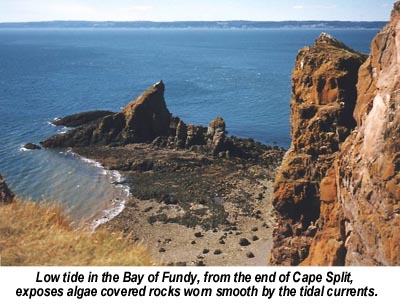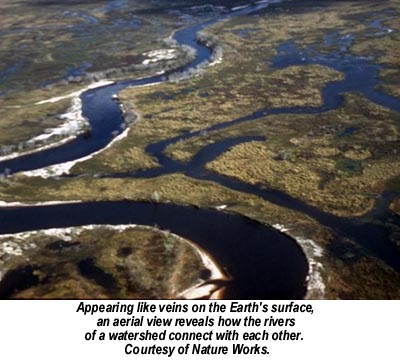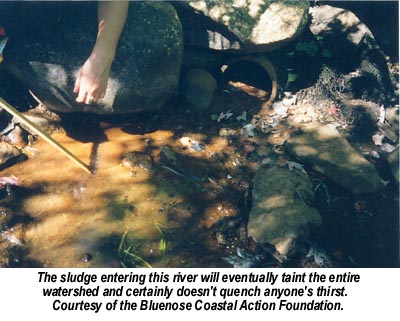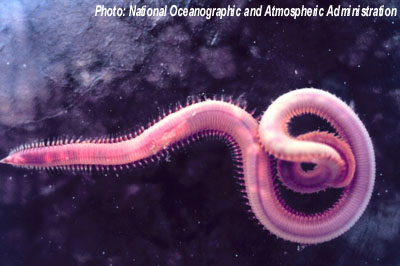Coastlines is a
public education project of the
Ecology Action Centre and is supported by
the Nova Scotia Habitat Conservation Fund and the Henry P. Kendall Foundation.
The following articles are reprinted with
the permission of the Ecology
Action Centre, Halifax, NS,
and with the assistance of Jennifer
Stevens, Project Coordinator,
Mushamush River Restoration Project, Bluenose Coastal
Action Foundation.
The Roar of Tides - by Jennifer Stevens
Watersheds: Where We All Live - By Heather MacLean
Our Watershed. Our Responsibility - By Heather MacLean
Life in the Mud - By Nicole Hynes
Rockweed’s Role in the Sea - By Jennifer Stevens
Nova Scotia's Bloodworm - By Ruth Lapp
A-Dulsing We Will Go - By Ruth Lapp
Invading Seaweed Alert! - By Annelise Chapman
The Roar of Tides
by Jennifer Stevens
The Bay of Fundy offers one of the most magnificent ecological phenomena of Nova Scotia. A remarkable display of the highest tides on Earth occurs here daily. There is actually more water flowing in and out of the Minas Basin at mid-tide than flows from all the rivers and streams in the world! Although the gravitational pull of the sun and moon significantly affects tides, the extraordinarily high Fundy tides are caused by the geographical location and unique shape of the Bay as well as by the resonance of the Bay of Fundy-Gulf of Maine system. Approximately 290 kilometres long, the Bay of Fundy is funnel-shaped, gradually narrowing until it splits to form Chignecto Bay and Minas Basin, the western and eastern extremities, respectively. The movement of huge masses of water in this area cause large currents called rip tides that reach over 15 meters high around peninsulas such as Cape Split.
The erosive effect of billions of tonnes of sea water moving in and out of the Bay of Fundy twice every 25 hours has sculpted much of the land in that area into spectacular cliffs and caves. One such structure, Cape Split, provides a spectacular view of one of Nova Scotia’s most famous rock formations. Jutting out near the entrance to Minas Basin, the tip of this hook shaped peninsula is only accessible by boat or by following a 16 kilometre hiking trail. It takes approximately four hours to complete the entire trail by foot and for a considerable distance a hollow roar emanates through the forest on the towering cliffs. Referred to as "voice of the moon", this haunting sound is emitted by the turbulent waters surging over the ridges below and is best heard near mid-tide. Regardless of how you choose to reach the pinnacle of Cape Split, the same panoramic scene is revealed; a stunning cliff-top view of the Bay of Fundy, 300 feet above the ocean.
Although there are so many amazing places to visit and marvels to observe in Nova Scotia, the four-storey high tides that fill the Bay of Fundy twice each day have gained a world-renowned reputation.
Jennifer Stevens has a biology and environmental science background.
Watersheds: Where We
All Live
By Heather MacLean
 There
has been recent debate in southeastern Nova Scotia
regarding potential residential property development
and the conservation of watersheds in the proposed building areas. For concerned
citizens, it is fundamental to understand the nature of watersheds and their
function within the environment in order to make an informed decision on the
growing conflict.
There
has been recent debate in southeastern Nova Scotia
regarding potential residential property development
and the conservation of watersheds in the proposed building areas. For concerned
citizens, it is fundamental to understand the nature of watersheds and their
function within the environment in order to make an informed decision on the
growing conflict.
Basically, everyone lives in a watershed. A watershed, also called a catchment basin, is an area of land that drains precipitation through a river system or group of river systems. Watersheds are comprised of streams, lakes, rivers and wetlands that empty into oceans and form transportation waterways. One watershed may be made up of many streams and rivers. There are two main forms of watersheds: closed watersheds empty into an inland body of water while open watersheds drain to the ocean.
Water is the lifeblood of the environment and it is essential to the survival of all living things - plants, animals and humans. Watersheds are home to a multitude of wildlife, including: trout, bass, perch, frogs, salamanders, birds, small animals, waterfowl and numerous types of vegetation. They also provide drinking water for humans and are used recreationally.
Watersheds are fragile ecosystems that sustain life of all things, including humans. When one section of a watershed is exposed to pollution of any kind, it not only threatens the exposed area, but in turn affects the entire watershed. Pollutants such as oil, paint, pet waste, debris, sediment, fertilizers and pesticides dumped directly into watersheds or washed by rain into gutters and storm drains have hazardous consequences. Ultimately, the contaminated water becomes part of the aquatic habitat and the toxins begin their damage on the living organisms.
According to Environment Canada, the preservation of watersheds is important for the health and integrity of our ecosystems and the communities that reside within them. Understanding the intricacies associated with the delicate nature of watersheds benefits both their wildlife inhabitants and humans alike. Watch for an upcoming Coastlines article describing the consequences and effects of watershed pollution.
Heather MacLean works in the public relations industry and is also a freelance writer in Halifax.
Our Watershed. Our Responsibility.
By Heather MacLean
 As
environmentally conscious citizens, many of us sort recyclables from garbage and
are aware of the benefits of organic composting. As we grow more concerned about
the depletion of the earth and ways to prevent further destruction, we should
remember that it is not only the land that needs protecting. It is also
necessary to focus on keeping our water systems clean. Every day watersheds
across Nova Scotia are inadvertently and sometimes intentionally polluted;
leaving lakes, rivers, streams, and brooks, that many species call home,
irreversibly damaged.
As
environmentally conscious citizens, many of us sort recyclables from garbage and
are aware of the benefits of organic composting. As we grow more concerned about
the depletion of the earth and ways to prevent further destruction, we should
remember that it is not only the land that needs protecting. It is also
necessary to focus on keeping our water systems clean. Every day watersheds
across Nova Scotia are inadvertently and sometimes intentionally polluted;
leaving lakes, rivers, streams, and brooks, that many species call home,
irreversibly damaged.
Disposing of any waste, regardless of the amount, negatively affects a watershed and eventually causes the entire system to become polluted. There are two types of pollutants that are of particular concern to water quality. According to Environment Canada, the first type is the most hazardous and rapidly growing and includes some pesticides, petroleum, petroleum products, PCB’s, and dioxins. These contaminants, including metals such as lead, mercury and cadmium, either break down very slowly or sometimes not at all, resulting in toxins that remain in the aquatic environment for years, causing significant damage. The harm they cause is either irreversible or takes decades to be removed from the system. The second type of watershed pollutants includes warm water from cooling towers, as well as floating debris and garbage. These are referred to as physical pollutants and although they are more easily broken down they can be extremely harmful to fish and other aquatic life.
It may take years for the toxins and harmful substances that are dumped into waterways to become evident. They still produce devastating effects whether we can see them or not. Everything from fish and plants to the water that humans use for drinking, bathing, cooking and cleaning is affected. It does not take long for the pollution source to disperse throughout the entire watershed.
Everyone is responsible for protecting our fragile watersheds. Residents and recreation enthusiasts alike share the responsibility of keeping chemicals and physical pollutants from entering watersheds. Through the purchase of environmentally friendly products and monitoring and reporting watershed pollution, we can help to ensure safe and healthy streams and rivers for generations to come.
Heather MacLean works in the public relations industry and is also a freelance writer in Halifax.
Life in the Mud
By Nicole Hynes
 When
peering out over the mudflats at low tide around the Bay of Fundy the last thing
that comes to mind are the thousands of tiny creatures teeming just below the
surface. The most important of these creatures is a tiny amphipod crustacean
called Corophium volutator. Ranging in size from a grain of rice as
juveniles, to 10 or 11 mm long as adults, Corophium can affect the entire
mudflat ecosystem and its productivity.
When
peering out over the mudflats at low tide around the Bay of Fundy the last thing
that comes to mind are the thousands of tiny creatures teeming just below the
surface. The most important of these creatures is a tiny amphipod crustacean
called Corophium volutator. Ranging in size from a grain of rice as
juveniles, to 10 or 11 mm long as adults, Corophium can affect the entire
mudflat ecosystem and its productivity.
Sometimes called mud shrimp, Corophium live beneath the surface in u-shaped tubes that are formed by gluing together tiny particles of sand. They emerge in search of food and mates but quickly return to the safety of their burrows. Their outer protective armour is similar to that of a lobster, divided into short segments each with a pair of limbs used for feeding or moving. According to the Department of Fisheries and Oceans, as many as 60,000 Corophium can be found in a single square meter of mud and can even be heard during low tide, producing a snap, crackle, pop sound.
As primary consumers, Corophium feed on microorganisms and organic matter. They belong to a short and unique food chain, being the most common prey of mudflat birds and fish. Each year millions of shorebirds flock to the Fundy shores, anxiously awaiting low tide so they can feed on Corophium. Sandpipers come to fatten up on this diet mainstay before their non stop migration to South America. Unlike us, they have never been fooled by the seemingly lifeless expanse of mud.
High tides are no safer for Corophium as they are also a food source for various fish species. Less is known about this relationship however, since it is hidden beneath the water. Other threats include human induced changes to the mudflats from causeways and worm or clam harvesting which can alter sedimentation and destroy burrows. Toxic materials that wash into the marine environment and nutrient runoff from agriculture practices can have negative effects as well.
Undoubtedly Corophium play a key ecological role in mudflat life, but there is always more to learn. The next time you dig your toes into the mud consider the thousands of Corophium volutator that may be just below the surface.
Nicole Hynes is an intern with the Salt Marsh Restoration Project at the Ecology Action Centre.
Rockweed’s Role in the
Sea
By Jennifer Stevens
 Walking
along the shores of the Bay of Fundy offers not only the tantalizing smell of
the sea but also a very intriguing and easily forgotten valuable coastal
habitat. At low tide thick, matted blankets of various seaweeds are visible
glistening in the sun, while the incoming tide transforms these algae masses
into a flourishing undersea forest. One of the most plentiful types of these
intertidal seaweeds is rockweed.
Walking
along the shores of the Bay of Fundy offers not only the tantalizing smell of
the sea but also a very intriguing and easily forgotten valuable coastal
habitat. At low tide thick, matted blankets of various seaweeds are visible
glistening in the sun, while the incoming tide transforms these algae masses
into a flourishing undersea forest. One of the most plentiful types of these
intertidal seaweeds is rockweed.
In Nova Scotia the dominant rockweed is Ascophyllum nodosum, or knotted wrack. It is the main brown seaweed in the intertidal zone along the Atlantic coastlines of the Maritimes. This type of rockweed can reach eight feet in length and clings to rocks with sucker-like holdfasts to avoid being washed away. It is generally darker brown at the base and a lighter olive green-brown at the tips. Specialized air-filled bladders along the shoots help to keep this macro alga floating upright as the tide rises, so that it receives sufficient sunlight.
For centuries, knotted wrack has been an important commercial seaweed in Canada. Within the Maritime Provinces, Nova Scotia produces the largest amount of rockweed and has been harvesting it for over 40 years. Although knotted wrack is well known for its value as an agricultural fertilizer, mulch, soil conditioner, and livestock feed, it is important to remember that this marine alga also plays an important role in coastal ecosystems.
 New shoots grow together, forming dense rockweed beds. These
provide a productive habitat for many invertebrates, fish and seabirds. The
cool, damp layer of vegetation protects the intertidal organisms from drying out
when the tide recedes. It also provides food and refuge for several commercially
important fish species such as pollock, herring and flounder. Sandflies, beach
fleas, bacteria, and fungi also benefit; decomposing piles of knotted wrack that
wash ashore and soon turn into a nutrient filled sludge. This natural fertilizer
eventually washes back into the sea to feed even more marine life. Knotted wrack
is a Maritime treasure not only for its source of agricultural and industrial
raw materials, but because, living and dead, it is an integral component of our
coastal ecosystems.
New shoots grow together, forming dense rockweed beds. These
provide a productive habitat for many invertebrates, fish and seabirds. The
cool, damp layer of vegetation protects the intertidal organisms from drying out
when the tide recedes. It also provides food and refuge for several commercially
important fish species such as pollock, herring and flounder. Sandflies, beach
fleas, bacteria, and fungi also benefit; decomposing piles of knotted wrack that
wash ashore and soon turn into a nutrient filled sludge. This natural fertilizer
eventually washes back into the sea to feed even more marine life. Knotted wrack
is a Maritime treasure not only for its source of agricultural and industrial
raw materials, but because, living and dead, it is an integral component of our
coastal ecosystems.
Jennifer Stevens works for the Bluenose Coastal Action Foundation,
an environmental organization on the south shore of Nova Scotia.
 Bloodworms
(Glycera sp.) belong to the phylum of animals
known as the Annelida (that include earthworms) and make their home along
Nova Scotia's coastlines in the intertidal and subtidal zones, submerged in
sand, mud and gravel. These marine worms lay their eggs in the early summer
months, when water temperatures warm up sufficiently. The worms swim to the
surface in swarms where they release their eggs and sperm.
Bloodworms
(Glycera sp.) belong to the phylum of animals
known as the Annelida (that include earthworms) and make their home along
Nova Scotia's coastlines in the intertidal and subtidal zones, submerged in
sand, mud and gravel. These marine worms lay their eggs in the early summer
months, when water temperatures warm up sufficiently. The worms swim to the
surface in swarms where they release their eggs and sperm.
Like many other marine annelids, bloodworms have stiff, hair-like bristles (setae) along the length of their body. They also have the fearsome feature of a beak-like proboscis, which they use to catch food and, when possible, give unwary humans a sharp nip.
For many years the commercial and recreational harvest of b!oodworms in Nova Scotia has been an unregulated fishery. Commercially, the worms are harvested for export to the sports fishing industry in the United States and Europe, and also as a source of feed for shrimp aquaculture. According to one report, per pound, marine worms are the most valuable natural resource of any major North American marine species.
Since the drastic decline of the bloodworm stocks along the coast of Maine, there has been an increase in demand for Nova Scotia's bloodworms. In Yarmouth County, where bloodworms have been a lucrative export business since the 1950s, one long-time bait dealer observed that the worms have almost disappeared from his area.
Many people feet that the species may be at risk. This has led to an increased interest in conservation. In 2002, the Department of Fisheries and Oceans (DFO) began issuing exploratory licenses to commercial marine worm harvesters.
Along the Hants Shore of the Minas Basin, some local residents have become increasingly concerned that the recent influx of commercial harvesters into their coastal region not only puts the bloodworm at risk, but also jeopardizes the habitat for certain fish species and migratory birds.
Science is only beginning to comprehend how tidal ecologies function. What is known is that the bloodworm and the many other marine invertebrates that inhabit the mudflats and subtidal zones of the Avon River and Minas Basin are integral to a finely tuned system of biological diversity. The Hants Shore Concerned Citizens group - comprised of local residents, fishermen, educators, and environmentalists - is currently working with DFO to find a sustainable solution to maintain the ecological integrity and unique marine habitat of this coastal region.
Ruth Lapp is a small-scale organic farmer and a member of
the
Food Action Committee at the Ecology Action Centre.
 The best time
to go dulsing is three days after the new moon; that's when you have your
highest tides," Alice Galley tells me. Alice should know. She has gathered dulse
for over 80 years near Bramber, along the Hants Shore. "Getting a high tide is
important," she says, "because the tide has to go a long way out in order to be
able to get on the dulse flats."
The best time
to go dulsing is three days after the new moon; that's when you have your
highest tides," Alice Galley tells me. Alice should know. She has gathered dulse
for over 80 years near Bramber, along the Hants Shore. "Getting a high tide is
important," she says, "because the tide has to go a long way out in order to be
able to get on the dulse flats."
Dulse (Palmaria palmata) is a red seaweed that commonly grows along the coasts of Nova Scotia. It can be found in the intertidal and subtidal areas of the Bay of Fundy, along the French Shore, all the way up to Digby.
The seaweed grows attached to rocks with a disc-shaped holdfast that supports the seaweed's flexible stipe, or stalk, and its leaf-like fronds. Although dulse can grow up to 40 centimetres long, it is usually shorter. It is an important food source and living space for many amphipods (small, shrimp-like creatures) and several species of molluscs.
Dulse may be found year-round. However, "dulsing," the tradition of gathering dulse to eat, usually happens during the warmer, summer months. In earlier times along the Hants Shore, dulsing had to wait until the hay was in, and the farm wagons and horse-teams were free to take folks out to the "flats." Dulse is gathered by hand, put into a bag, preferably a mesh or onion bag, and brought back to shore. On shore, the dulse is laid out flat to dry in the sun, where it turns a deep, brownish-purple colour.
I have heard several variations on how dried dulse can be eaten, including grabbing a handful and munching away, or adding it to soups or chowders. The most common culinary tradition is to toast the dulse on a wood-stove and eat it with fresh baked bread and lots of butter. For centuries, dulse has provided Nova Scotia's dulsers with a very nutritious wild-food, particularly high in iron, and surprisingly low in sodium.
While dulse is able to tolerate moderate human activity within its marine habitat, it does not respond well to prolonged increases in siltation, sedimentation, or pollution. Many dulsers also believe that the impact of fish dragger gear is particularly detrimental to the well-being of dulse habitat, since the seaweed can be torn from its holdfast and, with the churned up water, subjected to increased sedimentation.
Ruth Lapp is a small-scale organic farmer and a member of
the Food Action Committee at the Ecology Action Centre.
 Have you ever
wondered about the green, spongy, branched seaweed washed up more and more
frequently on beaches in recent years? Or have you heard from your local lobster
fisherman about the Japanese weed that now grows abundantly where kelp beds used
to be? Has it been mentioned by oyster growers that a strange green pest is
lifting the oysters right off the bottom and floating away with them?
Have you ever
wondered about the green, spongy, branched seaweed washed up more and more
frequently on beaches in recent years? Or have you heard from your local lobster
fisherman about the Japanese weed that now grows abundantly where kelp beds used
to be? Has it been mentioned by oyster growers that a strange green pest is
lifting the oysters right off the bottom and floating away with them?
Gradually, word is getting around about a species of seaweed (Codium fragile) that is native to Japan, but which is spreading throughout the world with human help. Attached to oysters that are being shipped between countries for aquaculture, or directly stuck to ship's hulls, the 'oyster thief' or 'green fleece' has managed to cross whole oceans, and, since the late 1980s, has become established in Nova Scotia, New Brunswick and P.E.I. The 'bio-invader' grows in tide pools and occurs below the low water line, mainly among kelp beds, which have locally changed to green underwater meadows of the new species. Not only does the 'spongeweed' spread over long distances, it also reproduces quickly and grows to three feet in one year. Whole plants and broken fragments can drift around and re-attach themselves to any rock, wharf., net or shell, and tiny reproductive cells help spread the newcomer even more effectively.
The local vegetarian critters, especially sea urchins, prefer their regular food, and stick with kelp as much as they can. Only if kelp is not offered on the menu will they try Codium. Although our urchins can digest the Japanese spongeweed just as well as kelp, it impairs their reproduction. With urchins being harvested in many areas around the Maritimes, and naturally rare in others, there appears to be no species that would be capable of keeping populations of the green fleece in check.
It looks like Codium is here to stay, and we might be convinced of its beauty, especially when viewed underwater. However, the green fleece could become another example of a new-comer changing native ecosystems and threatening local, biodiversity.
Annelise Chapman studies invading species at Dalhousie University.